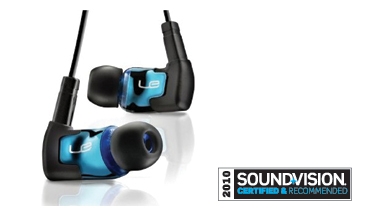In-Ear Headphones Face Off Page 4

Ultimate Ears TripleFi 10
Key Features |
| $400 Ultimateears.com |
| • Accessories: 6 pair ear tips, cleaning tool, airplane adapter, extension cord, stainless brushed metal carry case • Impedance/Sensitivity: 32 ohms/ 117 dB/mW |
Ultimate Ears was founded by a mixing engineer who starting building soundisolating in-ear stage monitors for musicians so they could hear themselves play without going deaf by standing in front of a blasting loudspeaker. The company, now owned by Logitech, is best known in the pro sound community for its custom in-ear monitors built from molds created for the user by an audiologist (a market that other brands here, including Shure, Etymotic, and Sleek, also play in). As noted elsewhere, my day-to-day earphones are Ultimate Ears's $1,150 top-of-the line UE 11 Pro, which I used in this test as a reference. The TripleFi 10, at $400, is UE's best non-custom model. It's a three-way design - the only one in our test - with separate armature drivers for the highs, mids, and bass. It has a more substantial earpiece than many of the lightweight in-ear models I tested, ranking right up there in size with the massive Monster Turbine and the Shure SE-420. The TripleFi is also the most efficient earphone in this test by a noticeable margin; it was easily driven by my iPod to substantial levels at settings near the middle of the 'Pod's volume scale. By comparison, virtually all the other 'phones (save the Etymotic Research ER-4P and my reference) required me to run the iPod up around three-quarters volume, if not higher.
PERFORMANCE
Bass test tones on the TripleFi revealed very solid energy at 30 Hz and little or no rolloff at 25 Hz. By 20 Hz, bass is down a bit but still quite present. This low-end performance made the TripleFi the best earphone among the competitors for truly deep-bass-dependent tracks like "Cosmic Rhythm Vibrations" from the Circle of Drums album. The opening moans and pounded drums on that cut went right to my chest and connected me with the music in a way no other earphone except for my reference could (although the Etymotic ER-4P, Sleek SA6, and Monster Turbine all also held their own quite well on this track).
Coupled with what turned out to be the TripleFi's uncanny dynamics and open sound, its low-end capabilities provided enough impact to even make the cannon shell from Sound Check sound like something more than a thin amusement. But for some listeners, and for certain recordings, I fear the TripleFi may have too much bass for its own good. Though the bass it delivers is real (information present on recordings, as opposed to artificially bloated upper bass), the TripleFi brings the bottom end of any recording to the forefront. That proved to be a problem on the Amanda Marshall track, for example, where the song's pumped-up bass line became bloated, indistinct, and distracting on the TripleFi - effects that were much tamer on my reference earphones and all the other test candidates. On the better-produced audiophile recordings, including the hip-hoppish Jason Weaver track, the TripleFi's bass sounded balanced and clear, never overpowering the rest of the music. But, boy, was it ever present, and if you opt for everything else the TripleFi does right, you'd better be ready to take that bass along with it.
Along with deep bass, it's that list of other stuff that puts the TripleFi among my top picks of all the earphones. First and foremost is an openness and spaciousness - the ability to recreate the "air" around the instruments as well as the space it was recorded in - that is simply unmatched by any other earphone in this test. Only moments into the Stravinsky Firebird finale, it was obvious that the TripleFi was a different animal. The sense of the hall was so grand, the instruments within so precise and detailed, and the dynamic range so realistic, that the TripleFi was the hands-down winner on this track as well. The tremendous power and ease with which the 'phones conveyed the crescendos, with those big kettledrums banging and the orchestra playing at full tilt, just clinched it.
These combined qualities carried through to a sense of realism and engagement with all the test tracks that most of the other 'phones struggled to attain. Some of the earphones did certain things better: The TripleFi's midrange and treble are not as refined as the Sennheiser's or the ER- 4P's, for example. Mids and highs sounded clear and clean, but there was a bit less of that silky smoothness and a bit more of an etched quality on the high notes and voices. Still, overall, this is a great earphone that brings the instruments and vocals to life with a high degree of accuracy.
BOTTOM LINE
A bass lover's paradise, the TripleFi plays loud and gets the spatial and dynamic challenges of demanding music tracks right.
- Log in or register to post comments





























































